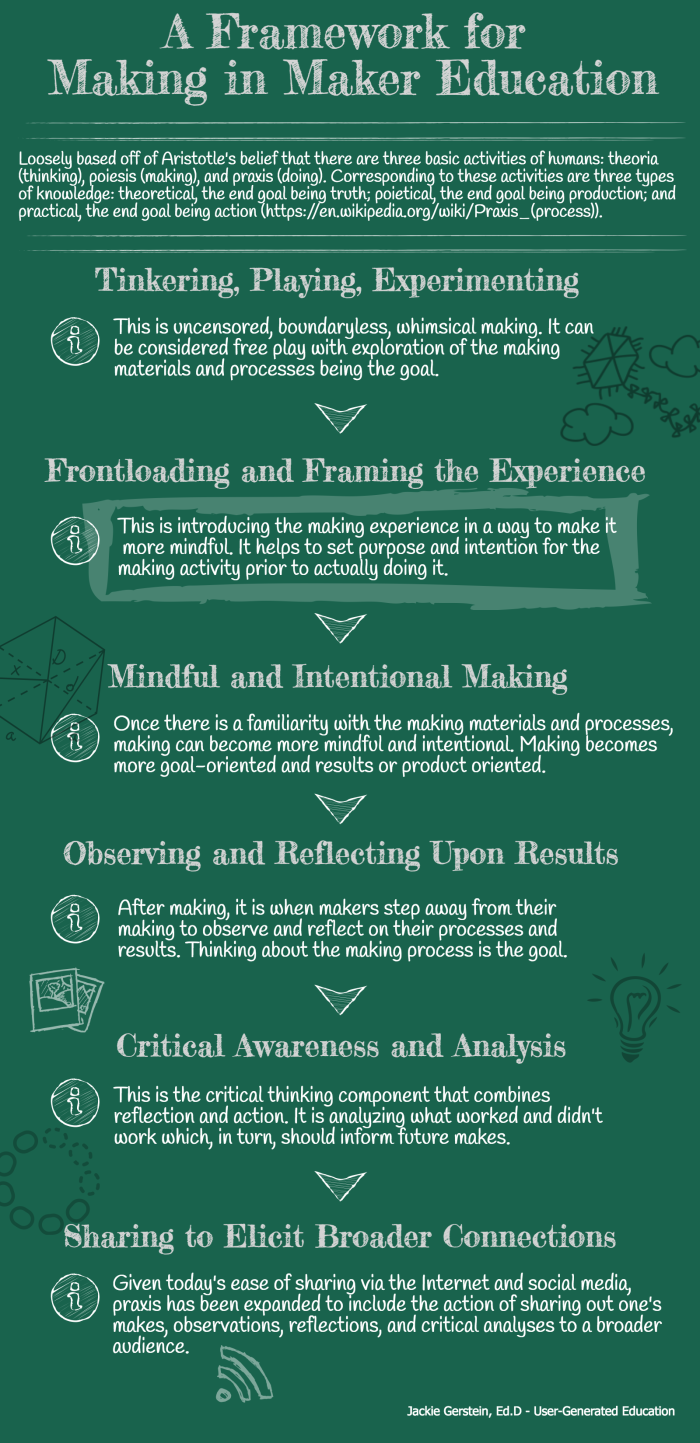A Fuller Framework for Making in Maker Education
Background Information
I recently learned, for the first time, about Aristotle’s belief that there were three basic activities of humans: theoria (thinking), poiesis (making), and praxis (doing). Corresponding to these activities were three types of knowledge: theoretical, the end goal being truth; poietical, the end goal being production; and practical, the end goal being action (https://en.wikipedia.org/wiki/Praxis_(process)).
The Greek theoria, from which the English word “theory” is derived, meant “contemplation, speculation, a looking at, things looked at”. The word theoria is derived from a verb meaning to look, or to see: for the Greeks, knowing was a kind of seeing, a sort of intellectual seeing (https://en.wikipedia.org/wiki/Theoria).
Poïesis is etymologically derived from the ancient Greek term ποιέω, which means “to make” (https://en.wikipedia.org/wiki/Poiesis).
Praxis (From ancient Greek: πρᾶξις) is the process by which a theory, lesson, or skill is enacted, embodied, or realized (https://en.wikipedia.org/wiki/Praxis_(process)). “Praxis” may also refer to the act of engaging, applying, exercising, realizing, or practicing ideas. Praxis may be described as a form of critical thinking and comprises the combination of reflection and action. Paulo Freire defines praxis “reflection and action directed at the structures to be transformed.”(https://en.wikipedia.org/wiki/Praxis_(process))
Implementing a Broader Framework of Making in Maker Education
All of this led me to think about how this would translate into a full spectrum of making in the context of maker educator. Having such a framework would help insure that learning from the making experience is more robust, not left up to chance. I believe a fuller spectrum or framework would including the following elements:
- Play, Tinkering, Experimentation – This is uncensored, boundaryless, whimsical making. It can be considered free play. This, in my mind, is the first part of of Poïesis which translated from Greek “to make”. How this translates into practice is by providing learners with lots of making materials; and telling them to just dive in and play hard with those materials.
- Framing or Frontloading the Making Experience – This is the introducing the making experience for more mindful and intentional making. It helps both the educators and learners to set purpose and intention for the making activity prior to actually doing it. This is discussed in Framing and Frontloading Maker Activities where I go in more detail how to frontload or frame the maker activities:
- Using and Reviewing Essential Questions
- Using Scenarios
- Specifying Standards
- Asking Questions Related To Personal Skills
- Asking Questions to Help with Scaffolding and Sequencing the Activities
- Asking Questions Related To Using Peer Support-Working Collaboratively
- Mindful and Intentional Making – Once there is a familiarity with the making materials and processes, making can become more mindful and intentional.This is the second part of poisis or the making process. Making becomes more goal-oriented, focused, and more results or product oriented (although process is still important).
- Observing and Reflecting Upon Results – This is the theoria or thinking part of the process. After making, it is when makers step back away from their making to observe and reflect on their processes and results.”Being able to reflect is a skill to be learned, a habit to develop. Reflection requires metacognition (thinking about your thinking), articulation of that thinking and the ability to make connections (past, present, future, outliers, relevant information, etc.)” (Amplifying Reflection).
- Critical Awareness and Analysis – This is the praxis, the critical thinking component that combines reflection and action. It takes reflection to a deeper level by dissecting the making process to analyze what worked and didn’t work which, in turn, will inform future makes. This critical analysis should directly and strongly influence future making experiences – the action part.
- Sharing to Elicit Broader Connections and Change – Given today’s ease of sharing via the Internet and social media, the action part of praxis has been expanded, in this framework, to include sharing out one’s makes, observations, reflections, and critical analyses to a broader audience. This can occur by writing about the making process, and/or by doing a photo essay, video, podcast to share via social media. By doing so, others can benefit from one’s make.


Sometimes I struggle to distinguish between making and doing.
lenandlar
October 23, 2016 at 8:13 pm
Yep – that’s why I did further reading on praxis
Jackie Gerstein, Ed.D.
October 23, 2016 at 8:15 pm
For simplicity I would leave making to actually making something, an artifact or so… and doing to a human activity that doesn’t necessarily lead to a developed outcome but some action …maybe walking for example…but that’s entirely novice a view i think
lenandlar
October 23, 2016 at 8:19 pm
Hi Jackie,
Would you recommend setting up a makers’ program for middle school students using the each aspect of the framework for a designated year. For eg. using play. tinker. experiment for the younger students aged 13 – 14, Framing and Front-loading for the 15 – 16, etc?
Or using the complete framework of 1) Play, tinker, experiment 2) Framing & Front-loading 3) Mindful and intentional making 4) Observing & reflection 5) Critical awareness and analysis 6) Sharing for broader connections to design the entire makers’ program?
Thank you
Jun Hien
Singapore
Jun Hien
May 7, 2018 at 1:09 am
Hi Jun – I use most parts of the framework for all ages/grades/maker projects – especially the framing and reflection. I just modify it a bit depending on the age and the project. Hope this helps!
Jackie Gerstein, Ed.D.
May 9, 2018 at 11:23 pm